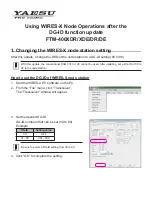
7700 MultiFrame Manual
7707IT Multi-Channel Intercom Fiber Transceiver
Page - 32
Revision 1.7
Audio for each channel may be configured for interface to Matrix or Party-line systems. Specifications for
these two intercom audio types are provided in section 3.1 of this manual. These specifications are
designed to accommodate systems from multiple manufacturers. Input/output functions of some audio
pins change with configuration. Please refer to the pin-out diagrams as shown in Figure 2-3 and Figure
2-4.
Never apply a powered or “wet” party-line signal to a terminal that is not
designated as a party-line connection.
Among the industry-standard matrix intercom products, two types of serial data are used for call signaling.
RTS-Telex uses RS-485 serial data, while ClearCom uses RS-422 serial data. The 7707IT
accommodates either of these through selection of the associated profiles. Input/output functions of
some serial data pins change with configuration. Please refer to the pinout diagram depicted in Figure 2-3
and Figure 2-4.
Among the industry-standard party-line intercom products, two types of call-signaling are used. RTS-Telex
uses a 20kHz frequency component superimposed upon the audio signal. ClearCom uses a DC voltage
component superimposed upon the audio signal. The 7707IT accommodates either of these through
selection of the associated profiles.
Therefore, four types of call-signaling are present in the industry; two types for matrix, and two types for
party-line. The 7707IT accommodates all of these via selection of an interface profile. This provides a
user-friendly means of configuring the 7707IT for a specific application.
7.5.1.2. Optical Control
This parameter enables the user to set the
Optical Power Threshold
over a range of –40 to +4dBm in
1dBm increments. Please heed the maximum optical input power specification for the specific product
option you possess.
7.5.1.3. Audio Detection Threshold Settings
This parameter enables the user to set the
Audio Detection Threshold
in order to properly indicate audio
signal presence. The audio detection threshold adjustment is implemented in the digital domain. For
matrix type intercom signals the specified range of threshold adjustment is –30dBu to +10dBu, in 1dB
increments. For party-line type intercom signals the specified range of threshold adjustment is –40dBu to
0dBu, in 1dB increments.
The audio detection threshold is independently adjustable for each channel, and is applied to both the
input and output of each respective channel. The detection thresholds are applied to the audio signals at
the input and output connections, which may have gain applied.





































